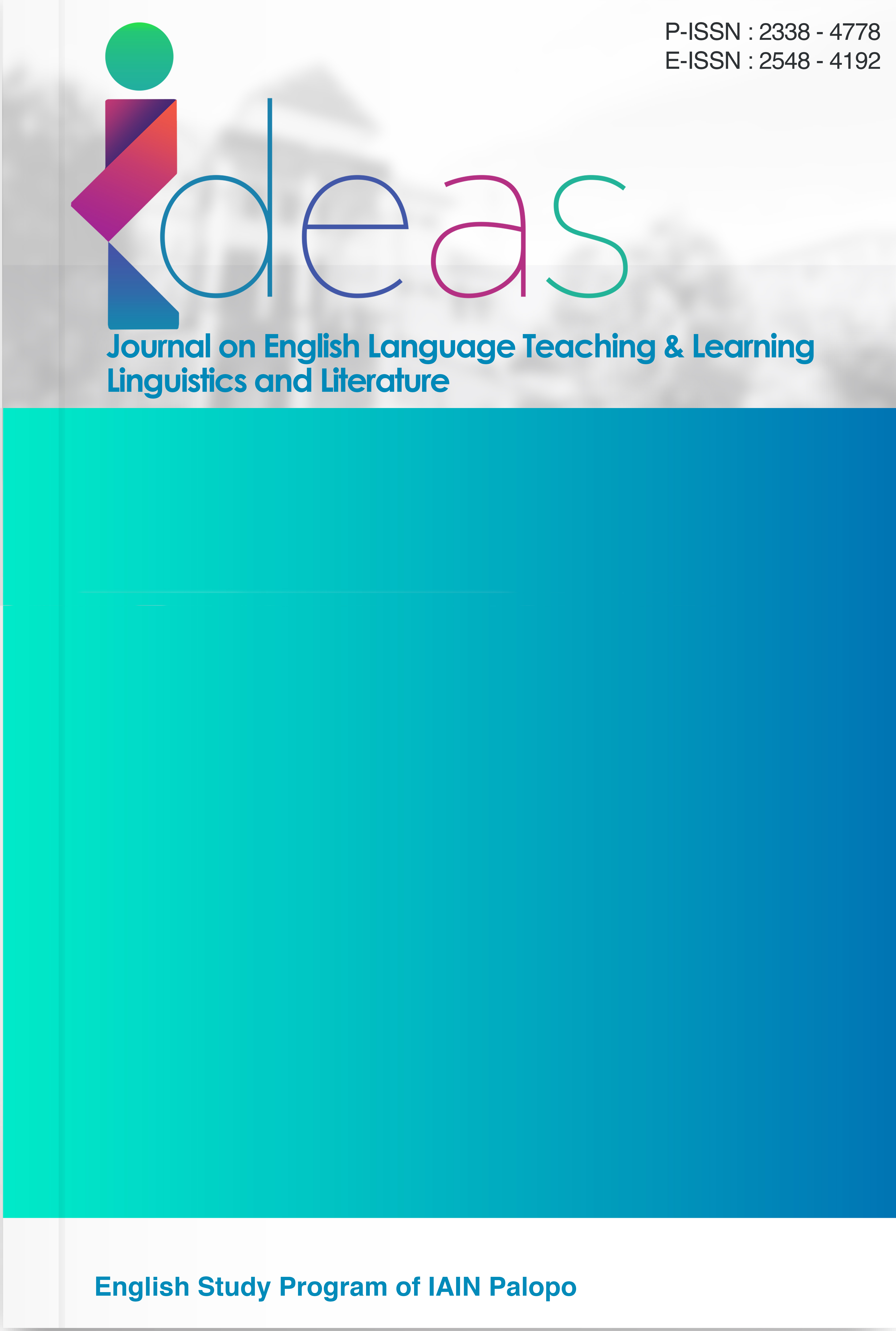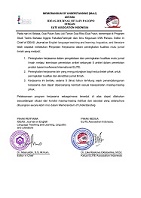Exploring the Emotional Labor Processes in Shaping Primary English Teachers' Professional Identity
DOI:
https://doi.org/10.24256/ideas.v13i2.6168Keywords:
Case Study, Emotional Labor Process, Primary Teacher, Teacher Professional IdentityAbstract
Language teachers were bound to perform many kinds of different emotions, known as emotional labor (EL), throughout their teaching experiences. However, despite the growing interest in recent years, the primary teachers’ emotions have been persistently ignored. This study thus aims to explore the emotional experiences of primary school English teachers in Indonesia on how those processes contribute to their professional identity. Employing a case study design, it seeks to deepen the understanding of teacher emotions by aligning data from questionnaires and semi-structured interviews (n=3) with the emerging theory of Emotional Labor Process (Hochschild, 2012). The findings reveal the dual impact of emotional labor (EL) on teachers' professional identity. Deep acting positively influences commitment by helping teachers align their emotional expressions with their professional values. This alignment strengthens their dedication and engagement in teaching. Conversely, if teachers experience significant stress and struggle their commitment may decrease. Surface acting, which involves faking or suppressing emotions, affects teachers' ability to manage stress effectively. Their ability in managing emotional labor impact their instructional beliefs and self-efficacy that undermining their confidence and teaching quality. This study highlights the need for emotional management training in teacher development programs to strengthen their capacity to navigate EL and maintain their professional identity. Furthermore, creating a supportive work environment is essential for sustaining teachers’ well-being and professional growth.
References
Abdul-Messie, L. (2023). “Trying to feel the right feeling for the job”: The emotional labour of English language teachers in state secondary schools in Italy. Social Sciences and Humanities Open, 8(1). https://doi.org/10.1016/j.ssaho.2023.100582
Akkerman, S. F., & Meijer, P. C. (2011). A dialogical approach to conceptualizing teacher identity. Teaching and Teacher Education, 27(2), 308–319. https://doi.org/10.1016/j.tate.2010.08.013
Beijaard, D., Meijer, P. C., & Verloop, N. (2004). Reconsidering research on teachers’ professional identity. Teaching and Teacher Education, 20(2), 107–128. https://doi.org/10.1016/j.tate.2003.07.001
Burić, I., & Frenzel, A. C. (2023). Teacher emotions are linked with teaching quality: Cross-sectional and longitudinal evidence from two field studies. Learning and Instruction, 88, 101-822. https://doi.org/10.1016/j.learninstruc.2023.101822
Carey, S., & Sutton, A. (2024). Early childhood teachers’ emotional labour: The role of job and personal resources in protecting well-being. Teaching and Teacher Education, 148. https://doi.org/10.1016/j.tate.2024.104699
Chaaban, Y., & Du, X. (2017). Novice teachers’ job satisfaction and coping strategies: Overcoming contextual challenges at Qatari government schools. Teaching and Teacher Education, 67, 340–350. https://doi.org/10.1016/j.tate.2017.07.002
Chan, W. Y., Lau, S., Nie, Y., Lim, S., & Hogan, D. (2008). Organizational and Personal Predictors of Teacher Commitment: The Mediating Role of Teacher Efficacy and Identification with School. American Educational Research Journal, 45(3), 597–630. https://doi.org/10.3102/0002831208318259
Chen, J. (2020). Teacher emotions in their professional lives: implications for teacher development. Asia-Pacific Journal of Teacher Education, 48(5), 491–507. https://doi.org/10.1080/1359866X.2019.1669139
Creswell, J. W. (2013). Qualitative inquiry & research design: choosing among five approaches. Sage eBooks. http://ci.nii.ac.jp/ncid/BB09168370
Diefendorff, J. M., & Gosserand, R. H. (2003). Understanding the emotional labor process: A control theory perspective. Journal of Organizational Behavior, 24(8), 945–959. https://doi.org/10.1002/job.230
Frenzel, A. C., Daniels, L., & Burić, I. (2021). Teacher emotions in the classroom and their implications for students. Educational Psychologist, 56(4), 250–264. https://doi.org/10.1080/00461520.2021.1985501
Gaan, N. (2011). Development of Emotional Labour Scale in Indian Context. Vision: The Journal of Business Perspective, 15(1), 41–48. https://doi.org/10.1177/097226291101500105
Hargreaves, A. (1998). THE EMOTIONAL PRACTICE OF TEACHING. teaching and teacher Education, 14(8).
Hochschild, A. R., Los, B., & London, A. (2012). The Managed Heart Commercialization of Human Feeling. University of California Press.
Hong, J. Y. (2010). Pre-service and beginning teachers’ professional identity and its relation to dropping out of the profession. Teaching and Teacher Education, 26(8), 1530–1543. https://doi.org/10.1016/j.tate.2010.06.003
Impedovo, M. A. (2021). Identity and Teacher Professional Development: A Reflective, Collaborative and Agentive Learning Journey. Springer. https://www.amazon.com/Identity-Teacher-Professional-Development-SpringerBriefs/dp/3030713660
Lamote, C., & Engels, N. (2010). The development of student teachers’ professional identity. European Journal of Teacher Education, 33(1), 3–18. https://doi.org/10.1080/02619760903457735
Lasky, S. (2005). A sociocultural approach to understanding teacher identity, agency and professional vulnerability in a context of secondary school reform. Teaching and Teacher Education, 21(8), 899–916. https://doi.org/10.1016/j.tate.2005.06.003
Lentillon-Kaestner, V., Guillet-Descas, E., Martinent, G., & Cece, V. (2018). Validity and reliability of questionnaire on perceived professional identity among teachers (QIPPE) scores. Studies in Educational Evaluation, 59, 235–243. https://doi.org/10.1016/j.stueduc.2018.09.003
Lu, C., Obenchain, K., & Zhang, Y. (2024). Exploring teachers’ inclination towards adopting inquiry-based learning in social studies: Insights from teacher professional identity. Teaching and Teacher Education, 145. https://doi.org/10.1016/j.tate.2024.104628
Miles, M. B., Huberman, A. M., & Saldaña, J. (2014). Qualitative Data Analysis: A Methods Sourcebook. SAGE. http://cds.cern.ch/record/2261864
Morris, S., & King, J. (2023). University language teachers’ contextually dependent uses of instrumental emotion regulation. System, 116. https://doi.org/10.1016/j.system.2023.103080
Mockler, N. (2011). Beyond ‘what works’: understanding teacher identity as a practical and political tool. Teachers and Teaching, 17(5), 517–528. https://doi.org/10.1080/13540602.2011.602059
Nurwati, N., Kaharuddin, K., Efendi, E., & Masruddin, M. (2021). Implementation of School Supervisory Academic Supervision as an Effort to Increase Teacher Performance in Junior High School. Journal of Indonesian Islamic Studies, 1(1), 28-37.
Nazari, M., Nejadghanbar, H., & Hu, G. (2023). Emotion labor and professional identity construction of TESOL teacher educators. System, 117. https://doi.org/10.1016/j.system.2023.103111
Nazari, M., Seyri, H., & Karimpour, S. (2023). Novice language teacher emotion labor and identity construction: A community of practice perspective. Teaching and Teacher Education, 127. https://doi.org/10.1016/j.tate.2023.104110
Peng, W., Liu, Y., & Peng, J. E. (2023). Feeling and acting in classroom teaching: The relationships between teachers’ emotional labor, commitment, and well-being. System, 116. https://doi.org/10.1016/j.system.2023.103093
Richards, J. C. (2022). Exploring Emotions in Language Teaching. RELC Journal, 53(1), 225–239. https://doi.org/10.1177/0033688220927531
Ritchie, K. C., Young, C., Hayre, K., Stemmler, P., King, S., & McGonnell, M. (2023). Exploring teachers’ emotions in Eastern Canada: Understanding positive, neutral and negative experiences. Social Sciences and Humanities Open, 8(1). https://doi.org/10.1016/j.ssaho.2023.100674
Soren, J. K. (2013). Teacher Identity in English-Medium Instruction: Teacher Cognitions from a Danish Tertiary Education Context. PhD Thesis. https://theses.hal.science/tel-00863816Sulistiyo, U., Haryanto, E.,
Van Huizen, P.H. 2000. Becoming a teacher: Development of a professional identity by prospective teachers in the context of university-based teacher education. Utrecht: Universiteit Utrecht.
Wang, H., & Burić, I. (2023). A diary investigation of teachers’ emotional labor for negative emotions: Its associations with perceived student disengagement and emotional exhaustion. Teaching and Teacher Education, 127. https://doi.org/10.1016/j.tate.2023.104117
Widodo, H. P., & Elyas, T. (2020). The portrait of primary school English in Indonesia: policy recommendations. Education 3-13, 48(8), 945–959. https://doi.org/10.1080/03004279.2019.1680721
Yin, R. K. (2017). Case Study Research and Applications. SAGE Publications.
Zembylas, M. (2003). Emotions and teacher identity: A poststructural perspective. In Teachers and Teaching: Theory and Practice 9(3) 213–238. https://doi.org/10.1080/13540600309378
Zhang, L., & Jiang, L. (2023). The role of emotion in Chinese preschool teachers’ identity construction. Teaching and Teacher Education, 123. https://doi.org/10.1016/j.tate.2022.104010
Downloads
Published
Issue
Section
Citation Check
License
Copyright (c) 2025 Vanya Maulidia Azizah, Ngadiso, Sri Haryati

This work is licensed under a Creative Commons Attribution-ShareAlike 4.0 International License.
Authors retain copyright and grant the journal right of first publication with the work simultaneously licensed under an Attribution-ShareAlike 4.0 International (CC BY-SA 4.0) that allows others to share the work with an acknowledgement of the work's authorship and initial publication in this journal.
Authors are able to enter into separate, additional contractual arrangements for the non-exclusive distribution of the journal's published version of the work (e.g., post it to an institutional repository or publish it in a book), with an acknowledgement of its initial publication in this journal.
Authors are permitted and encouraged to post their work online (e.g., in institutional repositories or on their website) prior to and during the submission process, as it can lead to productive exchanges, as well as earlier and greater citation of published work (See the Effect of Open Access)




